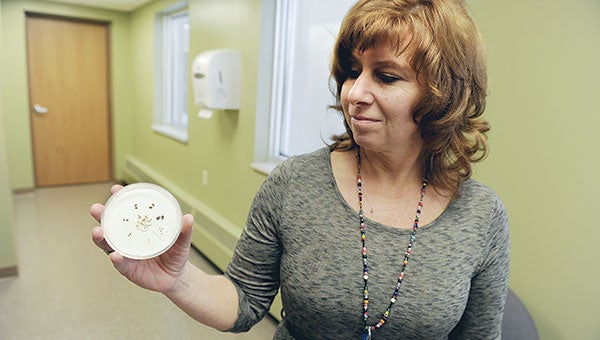A creepy, crawly issue
Published 10:36 am Friday, December 13, 2013

Pam Kellogg, nursing supervisor for Mower County Public Health, shows examples of the different stages of bed bugs Thursday afternoon. Bed bugs have become a problem in Mower County. Eric Johnson/photodesk@austindailyherald.com
Leaders concerned, but unsure how to best address bed bugs
An unexpected issue crawled into a forum with area legislators yesterday.
Mower County Health and Human Services employees invited state Sen. Dan Sparks, DFL-Austin, and state Rep. Jeanne Poppe, DFL-Austin, to an annual forum Thursday where they typically discuss funding concerns and other issues ahead of the legislative session.
But this year, county workers told Sparks and Poppe that bed bugs are becoming a big problem locally. Nursing Supervisor Pam Kellogg described the insects as a “very serious” issue.
“We have clients that they do have sores on their arms,” Kellogg said. “It does affect them.”
Many social workers, nurses and other employees frequently visit homes and apartments, and they’re concerned about the insects spreading. Public Health even has kits for employees that include surgical-type protective shoe coverings to prevent spreading the insects, especially into worker’s homes. One worker said they go into some homes, and they don’t know where to sit because the property is dirty or has bed bugs.
But, the bed bug issue may be crawling through the cracks.
Community Health Director Lisa Kocer said the Minnesota Department of Public Health’s stance is bed bugs are a pest and a nuisance, but not a public health threat because they don’t carry diseases.
“Cities have struggled with this because there really is no law,” Kocer said.
That means there’s no state regulations or funding available to help low-income and elderly people address bed bugs. Homeowners and renters can take steps to eradicate bed bugs on their own, but most are very expensive. In apartment buildings, Kocer said, bed bugs may just move if one apartment eradicates.
“Unfortunately, it’s very expensive to eradicate. … It’s really a difficult situation,” Kocer said.
While bed bugs garnered national attention about four or five years ago, Kellogg said, it has been an issue here for about two years.
Kocer noted it’s not just a problem faced by low-income residents, as bed bugs can spread easily through hotels, some new bedding and other day-to-day means.
Though bed bugs can affect anyone, officials said they’re seeing them a lot with low-income residents, and elderly or disabled residents who aren’t able to clean regularly.
“They’re very vulnerable,” Kellogg said.
Deb Heises, a social worker in the developmental disabilities unit, said she’s worked with multiple clients living in U.S. Department of Housing and Urban Development-subsidized housing who have used their own money to address bed bugs.
“It is rampant, and it has been a problem here for at least the last two years,” she said.
Kellogg said bed bugs are a key reason the Health and Human Services lobby has benches rather than upholstered furniture. When Health and Health Human Services workers visit homes they are told to sit on non-upholstered furniture or stand to avoid spreading bed bugs.
Workers like Heises say that’s difficult on visits, because it can come off as insulting and offensive to residents.
“It does affect people psychologically, physically, financially, mentally — on every aspect,” she said, adding bed bug bites are horrendous.
Another worker noted people lose services because of it, and some daycares won’t allow children in the center if there are bed bugs in the home.
According to Kellogg, some apartment complexes won’t allow residents to move from a building known to have bed bugs. Many service providers — homemaking services, homecare agencies, mental health services, etc. — won’t come into a building with bed bugs.
Landlords are not required to take action, and it’s a tricky issue, especially in public subsidized housing and apartment buildings. Often, it’s impossible to know if bed bugs were present before a resident moved in or if a new tenant brought them into the apartment.
Poppe said she’s not sure who it falls on to correct the problem, but she suggested the county, city, Austin Area Landlord Association, Austin Housing and Redevelopment Authority, and other groups work together to at least ensure the public is aware of the issue.
“If it’s a problem, we need to raise the awareness; we need to figure out how to solve it,” Poppe said.
However, Poppe doesn’t necessarily see the Legislature taking action.
“Sometimes there doesn’t need to be a law, if good common sense can prevail, and people can kind of recognize that something needs to be done,” Poppe said.
Public awareness may be the first step, as Commissioners Tim Gabrielson and Polly Glynn admitted they know about the issue.
“I was not aware that the problem was that big in Mower County,” Glynn said.
Kellogg said perhaps area leaders could work toward setting up a volunteer group to help apartment buildings and area residents.
Kellogg said local apartment buildings are working to eradicate the bugs, but there’s no easy or cheap fix.
“They are trying, but if you don’t clean your apartment, you can sit and do all kinds of treatments, but it’s just not getting rid of it,” she said.
According to Kocer and Kellogg, some apartment buildings have ended sharing programs that leave old furniture for other residents. Kocer said she believes bed bugs are probably no more serious in Mower County than in other communities.
Workers worried about lack of area treatment centers
Health and Human Services workers also expressed concern about the difficulty of finding treatment facilities, especially local treatment facilities, for residents in need.
Workers voiced concerns that many adolescents who have behavioral problems and need treatment for medical, psychiatric and mental health issues have few placement options and often need to be placed in facilities as far away in places like Wisconsin and Duluth.
“It really is hurting the people we serve,” Social Worker Colleen Horn said. “People shouldn’t have to live two, three hours away from their families because they have service needs.”
Workers said they often spend countless hours working to secure placements, and they’re not always sure they’re the best option.
One woman said the children are as young as 8, and she said one 10-year-old was placed in a hospital because there were no child psychiatric beds.
Family foster care is not the answer, she said.
One worker said the county is keeping levy costs low at the expense of affecting services to the most vulnerable: the elderly, needy people, etc.
Both Poppe and Sparks said events like Thursday’s forum are an important way to stay in touch with their constituents.
“We really do have to take care of our most vulnerable,” Sparks said.
Poppe said it’s an important way to be aware of issue going on in the public.
Sparks said they were pleased to continue the yearly meeting after snow caused them to cancel it last year.
“This is one of the most worthwhile meetings that we attend,” Sparks said.






